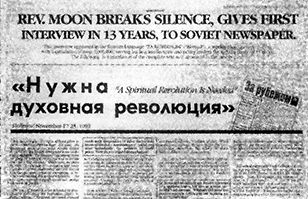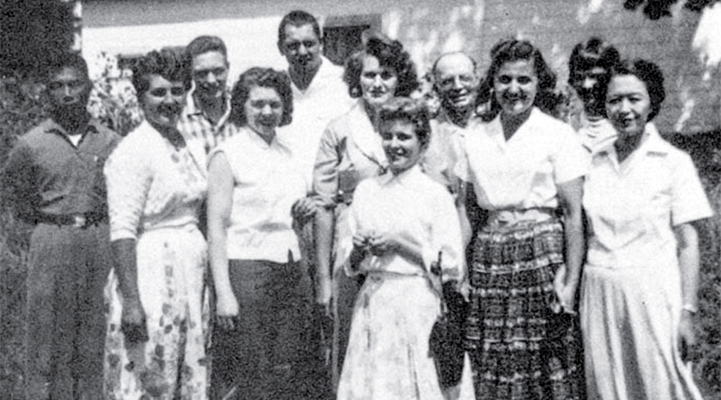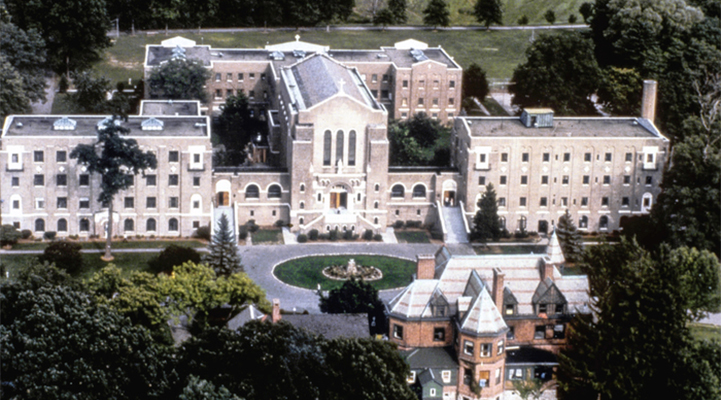What Our World Needs Most
This week in history, November 16-22:
- A Soviet journalist interviews True Father
- True Father is released from Pyongyang Jail
- Young Oon Kim relocates to San Francisco
- UTS is granted a “provisional charter” by the State of New York
November 17, 1989
Soviet Journalist Interviews True Father

The Soviet interview with True Father was reprinted in major U.S. newspapers.
In a sign of things to come, True Father granted his first interview in 13 years to Za Rubezhom (“Abroad”), a Soviet newsweekly with a circulation of over 1 million that was read by intellectuals and policy leaders throughout the Soviet Union. Za Rubezhom titled the interview “A Spiritual Revolution Is Needed” and published it the week of November 17-25 in its “Religion and Society” section. The interview was translated into English and published in advertisements in major newspapers around the United States under the banner head “Rev. Moon Breaks His Silence.”
True Father spoke about his daughter-in-law Hoon Sook (Julia) Moon’s dance performance on the stage of the Kirov Theatre and his respect for Russian artistic traditions; President Mikhail Gorbachev’s efforts to launch glasnost (“openness”) and perestroika (“restructuring”); and the need for the Soviet Union to support religious freedom and develop “a wider-based individual incentive system” for its commerce. He said that he welcomed the “lessening of tensions among the nations of the world” but that lasting peace would come only when we “settle our peace with God.”
“What our world most needs,” True Father stated, is “a spiritual revolution. Then we can successfully solve our economic and social problems.” True Father’s interview with Za Rubezhom culminated a decade of groundwork by the World Media Association in cultivating contacts among Soviet journalists and was a steppingstone to the 11th World Media Conference in Moscow and True Parents’ meeting with President Gorbachev in April 1990.
November 21, 1946
True Father Released from Pyongyang Jail
True Father undertook mission work in North Korea beginning in June 1946. Some two months later, on August 11, 1946, he was arrested by police in Taedong, a district of Pyongyang. In jail, he met members of the “Inside-Belly” Church whose leader also had been arrested. That church had been preparing clothes and food for the Lord’s Second Coming. On September 18, 1946, True Father passed a message to its leader, Mrs. Hyo Bin Heo, which stated. “The writer of this note has a mission from heaven. Pray to find out who he is. … ” The note was discovered and True Father was subjected to severe torture which included sleep deprivation and savage beatings. On November 21, a Soviet interrogator determined that True Father was not a spy from the South, and authorities notified followers that they should come and get him. According to one account, True Father was thrown out into the yard, half dead from the beatings, his clothes stuck to his body by clotted blood. He vomited blood, and those helping him thought he might die. However, after three weeks he began to improve. True Father wrote in his autobiography, “Once I recovered, I resumed my evangelical work.” Mrs. Hyo Bin Heo perished in prison.
November 21, 1960
Young Oon Kim Relocates to San Francisco

Young Oon Kim with early members gathered at Oak Hill.
Young Oon Kim, “Miss Kim” to early American members, was the first Unification Church missionary to the United States. A former professor at Ehwa University in Seoul, she came to Eugene, Oregon, as an exchange student at the University of Oregon in January 1959. There she witnessed and gathered a small community who resided in Oakhill, a rural settlement outside Eugene. The group dedicated themselves to outreach and production of Miss Kim’s English translation of the Divine Principle text. In September 1960, two female members fled Oakhill due to persecution from their husbands. They went first to Fresno, California, then to San Francisco. In part, because their husbands continued to harass the group, mainly by target shooting in the field across from where Miss Kim lived, she and three of her core members decided to relocate. Miss Kim wrote:
Eugene was a small, conservative city, where I went not by choice, but to follow my scholarship. Next I went to Oakhill, which was only a small settlement in the countryside. There I spent time raising those who had accepted and deepening their understanding of the Principle, as well as teaching the Principle in Lebanon, Salem, Albany, and Portland. … I found Oregon quite provincial on the whole, though, and was not reluctant to leave. I yearned to launch my work in a cosmopolitan city. I now had a textbook for wider work. … It seemed like this was where Father was leading me.
Miss Kim’s group severed ties irrevocably with the Northwest and began a new chapter of Unification Church history in the San Francisco Bay Area.
November 21, 1986
UTS Granted “Provisional Charter” by the State of New York

An aerial view of UTS.
Unification Theological Seminary obtained a “provisional charter” to grant academic degrees on November 21, 1986. By a 12-2 vote, the New York State Board of Regents approved the Seminary’s provisional charter and master plan. UTS graduates would now receive master’s degrees in either Religious Education (M.R.E.) or Divinity (M.Div.). This action marked the end of a 10-year battle to attain recognition. A previous attempt to gain a provisional charter, submitted in 1976, was denied in 1978. UTS took the matter to court, claiming discrimination and unfair treatment, narrowly losing a 4-3 decision of the New York State Court of Appeals in 1981. Reapplication for the charter was made in April 1984. Some 450 students who had attended UTS prior to 1986 graduated with “certificates” rather than degrees. It would be another four years before the State of New York granted UTS its “Absolute Charter,” some 15 years after its initial application.
This Week in History briefly lists significant events in the history of the Unification Church, the lives of the Founders, and world events that are momentous to Unificationists. Most items are marked according to the solar calendar. Items marked “H.C.” correspond to the Cheon-gi or Heavenly Calendar, which is based on the lunar calendar. This installment covers the week of November 16-22.


Eric Sylte
| #
The article stated “Miss Kim’s group severed ties irrevocably with the Northwest”. Well, they did make an exodus from Eugene in 1960, but some returned a few years later when Holy Grounds were established and some from her group have continued to live in the Northwest through the years and some continued mission work here.
Reply
Cynthia
| #
Great pictures!
Reply